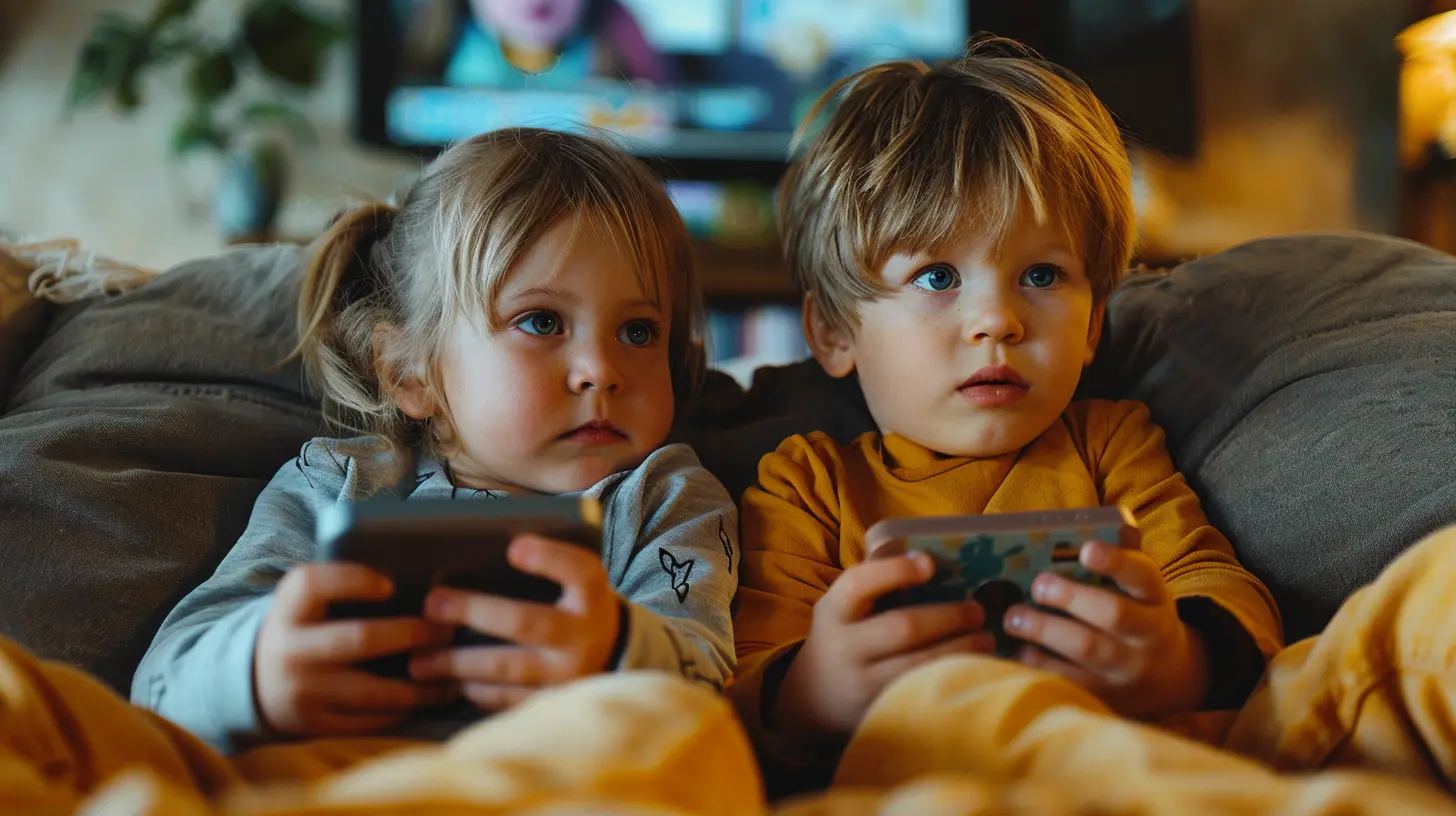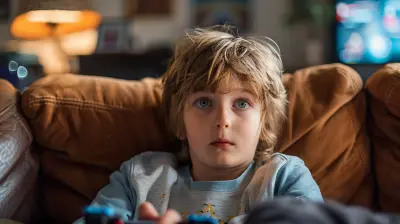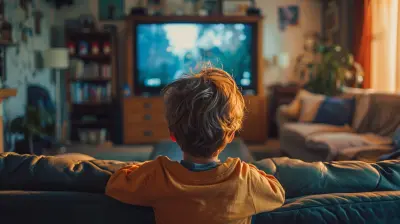24 January 2025
Ah, sibling relationships. One moment, they’re reenacting a WWE SmackDown in your living room. The next, they’re cuddled up on the couch like the poster children of sibling camaraderie. It’s a beautiful, chaotic mess—a little like cooking spaghetti when you’re out of sauce. But have you ever noticed how much worse their "quality time" gets when they're glued to screens? Yep, screens: the modern-day black hole sucking away all their attention (and your sanity).
So, what if I told you that cutting down on screen time could transform your kids from squabbling rivals into something resembling best friends? No, I’m not promising miracles here—they’ll still argue over who gets the last slice of pizza—but trust me, there’s some magic in getting those screens out of the way. Ready to dive in? Let’s talk about why limiting screen time might just save sibling relationships—and your eardrums.
The Great Divide: How Screens Wreck Sibling Dynamics
Picture this: your kids, side by side, staring at glowing rectangles like they’re moths to a flame. They might as well be in different dimensions. One’s watching a hamster play the ukulele on YouTube, while the other is conquering Minecraft like they’re auditioning for a virtual Hunger Games. They’re both physically in the same room, but emotionally? Worlds apart.Screens create a kind of ant-social behavior—yep, I just made that up. Instead of using their imaginations or actually having conversations (remember those?), kids turn inward, zoning out in their own little tech bubbles. Don’t even get me started on how screens amplify their ability to ignore everyone, including each other. You could shout “dinner’s ready!” five times, and they’d respond faster to a Roblox notification. 
The Real MVP: Face-To-Face Interaction
Here’s the thing: relationships need face time. No, not FaceTime™, like actual in-person interaction where they look each other in the eye, not through an iPad screen. When you limit screen time, siblings are forced (yes, it might feel like torture at first) to interact face-to-face. And guess what? That’s where the magic happens.Without screens acting as an escape route, kids start talking to each other. They play games. They share jokes (even if it’s just making fun of your outdated dance moves). These interactions build memories, teach them how to communicate (read: how to argue without throwing things), and—dare I say it—foster actual bonding. It’s like giving them an empty canvas and saying, “Go create something together.” Sure, the first few strokes might look like a hot mess, but eventually, you’ll get a masterpiece. Or at least finger-paint-worthy teamwork.
The Boredom Factor: A Secret Weapon?
Let’s address the elephant in the room here—boredom. You know, that terrifying state when your kids look at you with wide, desperate eyes and declare, “I’m bored!” Well, congrats, Mama or Papa Genius. Boredom is actually your secret weapon.Why? Because boredom forces creativity. When kids aren’t mindlessly scrolling through TikTok or bingeing Bluey for the 1,000th time, they actually have to think. And when they think, they come up with ideas. Maybe they’ll build a fort out of sofa cushions. Maybe they’ll play an epic game of hide-and-seek that ends with one of them stuck inside the laundry basket. Maybe they’ll argue over who gets to be the “evil villain” in their made-up story. Whatever it is, it’s infinitely better than them sitting like zombies in front of a screen.
And here’s the kicker: when siblings get bored together, they often end up entertaining each other. It’s like watching a mini sit-com unfold in your living room—only this time, there are no commercial breaks and no “pause” button when they’re driving you nuts.
The Power of Teamwork (AKA Sibling Shenanigans)
When screens are out of the way, you’ll notice something miraculous happen—your kids might actually team up! It could be to prank you (sorry in advance) or to build a Lego tower taller than themselves. Either way, teamwork strengthens their bond.You see, working on tasks together—whether it’s building that fort or just surviving a backyard "mission” to find hidden treasure—teaches kids important life skills. They learn cooperation, problem-solving, and even conflict resolution. (Translation: they learn how to argue over whether the fort should have two “doors” or one but eventually settle it like semi-reasonable humans.)
When siblings team up, they start seeing each other as allies rather than competitors. It’s like the Avengers, but with fewer superpowers and more peanut-butter-stained t-shirts.
Less Screen Time, Fewer Fights (Kind Of)
Okay, let’s not pretend that limiting screen time will magically eliminate sibling fights altogether—because, honey, that’s just not happening. Siblings argue; it’s practically a rite of passage.But here’s what happens when you cut back on screen time: the fights shift. Instead of fighting over whose turn it is to play Mario Kart, they start debating which game to play outside or whose “house” (made of pillows) gets to be the bakery. Sure, it’s still arguing, but it’s the kind that builds communication skills instead of feeding tech addiction. In the long run, these kinds of conflicts actually bring them closer together. Weird, right?
But What About MY Sanity?
I hear you. You’re thinking, “Great, but if I take away their screens, I’ll have to entertain them all day!” Not true. First of all, as a parent, you’re not legally obligated to provide 24/7 entertainment. Secondly, remember that magic word: boredom. Let them stew in it for a bit, and eventually, they’ll figure it out.Plus, the more time they spend bonding and playing with each other, the less reliant they’ll be on you for entertainment. Before you know it, they’ll be off in their bedroom giggling about some inside joke, and you’ll finally get a moment to drink your coffee before it turns cold. Or at least lukewarm.
Tips for Easing the Screen-Time Transition (Without Mutiny)
Cutting down on screen time can be a bit...let’s say “challenging” when you first start. (Translation: there might be tears. And dramatic proclamations of boredom. And potential threats to move to Grandma’s house.) Here are a few tips to make the process less painful:1. Set Clear Rules
Kids love rules as much as you love stepping on Legos (read: not at all). But clear guidelines make the transition easier. Try something like “One hour of screen time after chores are done” or “No screens after dinner.”2. Offer Fun Alternatives
Swap screens for board games, craft projects, or backyard adventures. (Pro tip: Hide the markers if you value your walls.)3. Lead by Example
Yeah, I went there. It’s hard to convince your kids to ditch their screens when you’re binge-scrolling Instagram during family movie night. Cut back on your own screen time, and they’ll be more likely to follow suit. Monkey see, monkey do, right?4. Stick to It
They’ll test your limits. They’ll whine. They’ll bargain. (“What if I just watch Minecraft videos without actually playing Minecraft?”) Stay strong, my friend. The benefits are worth it.The Bigger Picture: Lifelong Benefits
At the end of the day, cutting back on screens isn’t just about sibling bonding—it’s about setting your kids up for healthy relationships in the long run. By teaching them to engage with each other now, you’re giving them social skills that will serve them for life. And who knows? Maybe 20 years from now, they’ll look back and laugh about that epic pillow fort they built together instead of arguing over whose Roblox world was cooler.And if all else fails, remind them that they’ll need each other when they’re older. After all, who else is going to help them gang up on you about how embarrassing you were?









Lorelei Jordan
In the glow of less screens, sibling bonds bloom, laughter dances, hearts entwine.
March 18, 2025 at 4:20 PM